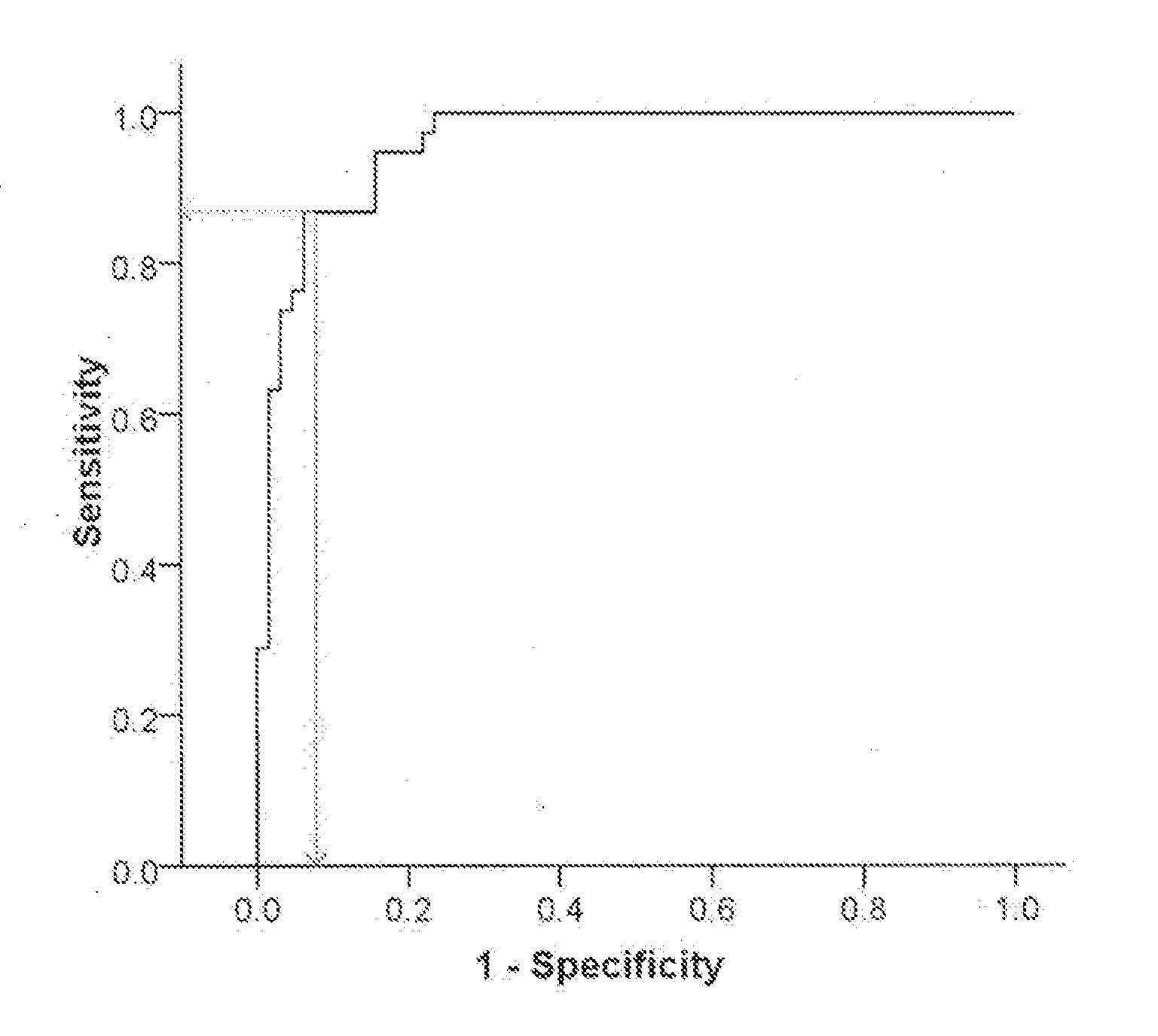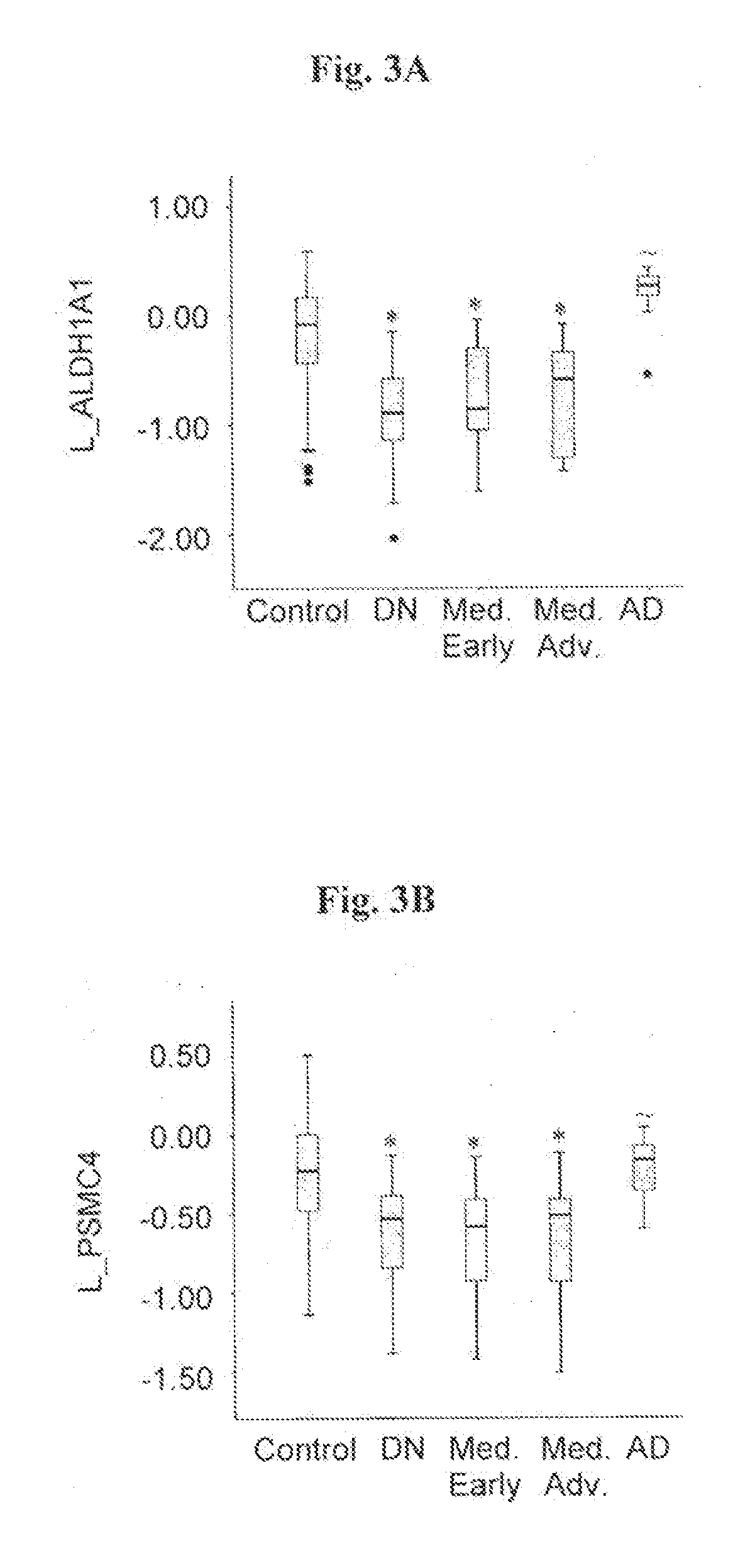Peripheral blood gene markers for early diagnosis of parkinson's disease
a gene marker and parkinson's disease technology, applied in the field of molecular risk marker profiles for the diagnosis of parkinson's disease, can solve the problems of insufficient pd specificity and sensitive diagnosis of tools, no laboratory blood test for pd is available, and the cost-effectiveness remains a problem, so as to achieve increased or decreased expression levels
- Summary
- Abstract
- Description
- Claims
- Application Information
AI Technical Summary
Benefits of technology
Problems solved by technology
Method used
Image
Examples
example 1
Evaluation of the Stability of Blood Reference Genes
[0126]The relative quantification of expression levels is based on the expression levels of target genes vs. one or more references i.e., reference or control, genes. The normalization procedure is mandatory in quantitative RT-PCR (qRT-FCR) studies and the reason for the choice of the most stably expressed reference genes is to avoid misinterpretation and low reproducibility of the final results.
[0127]We decided to determine the expression stability of live widely used reference genes, in particular, ACTB, GAPDH, ALAS1, PPIA and 60S RPL13A, in human leukocyte samples from PD and healthy age-matched controls, randomly divided between males and females.
[0128]RNA from blood samples of patients and controls was extracted and reverse transcribed, and expression was determined by quantitative Real-Time RT-PCR, as described in Materials and Methods.
[0129]The expression of the selected control genes in samples was analyzed with two widely ...
example 2
Identifying a PD Risk Marker Panel in Peripheral Blood
[0131]In order to identify a PD risk marker panel in peripheral blood with high probability to detect early PD, we have focused on non-medicated de novo PD patients to track for gene changes at very early stages of the disease and to ascertain no confounding bias that could arise from medication.
[0132]The transcriptional expression level of eight genes, in particular, ALDH1A1, PSMC4, SKP1A, HSPA8, CSK, HIP2 and EGLN1, which have previously been found to be altered in substantia nigra tissue from sporadic PD patients (Grünblatt et al., 2004); and CLTB, elected from the transeriptomic PD blood analysis of Scherzer et al., (2007), were assessed in blood samples from 38 individuals with de-navo PD, and 64 healthy age-matched controls without neurological dysfunction. (Table 1).
[0133]RNA from blood samples obtained from each one of those individuals was extracted and reverse transcribed, and expression level of each one of said genes ...
example 3
Characterizing Partial Risk Marker Panels
[0140]We next tested the ability of partial risk marker panels, including genes selected from the full six-genes risk marker panel, established and described in Example 2, to differentiate between PD de novo patients and healthy controls. A stepwise multivariate logistic regression analysis was conducted as described in Materials and Methods, and stopped after finding three, four, or five genes of the full six genes panel. A ROC curve was used to calculate the relationship between sensitivity and specificity for the de-novo PD group vs. healthy controls for each of the partial risk marker panels, and thus evaluate the diagnostic performance of the identified gene clusters. The results are presented in Table 5A and regression coefficient (B) values for the predicted probability equation for each partial panel are given in Table 5B.
[0141]The predicted probability for PD (p(PD)) for each one of these partial risk panels can be calculated using t...
PUM
| Property | Measurement | Unit |
|---|---|---|
| density | aaaaa | aaaaa |
| phase | aaaaa | aaaaa |
| rigidity | aaaaa | aaaaa |
Abstract
Description
Claims
Application Information
 Login to View More
Login to View More - R&D
- Intellectual Property
- Life Sciences
- Materials
- Tech Scout
- Unparalleled Data Quality
- Higher Quality Content
- 60% Fewer Hallucinations
Browse by: Latest US Patents, China's latest patents, Technical Efficacy Thesaurus, Application Domain, Technology Topic, Popular Technical Reports.
© 2025 PatSnap. All rights reserved.Legal|Privacy policy|Modern Slavery Act Transparency Statement|Sitemap|About US| Contact US: help@patsnap.com



